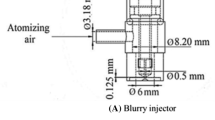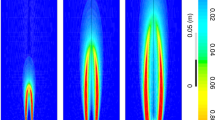Abstract
Experimental work was conducted to investigate the flame stability limits of H2 + C3H8, H2 + C2H6 and H2 + CH4 jet flames by using a single jet diffusion burner with a nozzle diameter of 2 mm. The results of 400 experimental tests showed that the increment of hydrogen composition increases the stability limits of the hydrogen-hydrocarbon jet flames. Furthermore, the results also showed that H2 + C3H8 jet flames could be effectively lifted or blown out at a lower jet exit velocity than H2 + C2H6 and H2 + CH4 jet flames at similar H2 concentrations. In addition, it was observed that the H2 + CH4 jet flame exhibits the highest blowout velocity. It was also found that the stability limit of hydrogen-hydrocarbon jet flames starts to increase rapidly at hydrogen volumetric composition of 90% for H2 + C3H8, 85% for H2 + C2H6 and 70% for H2 + CH4.










Similar content being viewed by others
Abbreviations
- H2 :
-
Hydrogen
- CH4 :
-
Methane
- C2H6 :
-
Ethane
- C3H8 :
-
Propane
- NTP:
-
Normal temperature and pressure (20 °C and 101.3 kPa
- ρ:
-
Density (kg/m3)
- \(\overline{\rho }\) :
-
The density ratio of the gas at the jet exit ρe to the density of the ambient air c
- ρe :
-
The density of the exiting fluid at 298 K (kg/m3)
- ρ∞ :
-
The density of the ambient air at 298 K (kg/m3
- C2 :
-
Constant which valued 50 (used in Eq. 1)
- do :
-
An inner diameter of the burner (mm)
- h:
-
Lift-off height (mm)
- Re H :
-
Reynolds number of the exit jet
- Re su :
-
The turbulence Reynolds number
- SL :
-
Laminar burning velocity (m/s)
- Ue :
-
Jet exit velocity (m/s)
- Ublowout :
-
Blow-out velocity (m/s)
- Ve :
-
The kinematic viscosity of the jet exit (m2/s)
- Vjet :
-
Viscosity (m2/s)
- XH2 :
-
Mole fraction of Hydrogen
- Yo :
-
Fuel mass fraction at the burner exit
- Ys :
-
Fuel fraction needed for stoichiometric burning
- Yst :
-
Stoichiometric mass fraction
References
Bradley D et al (2016) Jet flame heights, lift-off distances, and mean flame surface density for extensive ranges of fuels and flow rates. Combust Flame 164:400–409
Choudhuri AR, Gollahalli SR (2000) Combustion characteristics of hydrogen-hydrocarbon hybrid fuels. Int J Hydrogen Energy 25(5):451–462
Choudhuri AR, Gollahalli SR (2003) Characteristics of hydrogen-hydrocarbon composite fuel turbulent jet flames. Int J Hydrogen Energy 28(4):445–454
Coppens FHV, De Ruyck J, Konnov AA (2007) Effects of hydrogen enrichment on adiabatic burning velocity and NO formation in methane + air flames. Exp Thermal Fluid Sci 31(5):437–444
Eickhoff H, Lenze B, Leuckel W (1985) Experimental investigation on the stabilization mechanism of jet diffusion flames. Sympos Int Combust 20(1):311–318
El-Sherif AS (1998) Effects of natural gas composition on the nitrogen oxide, flame structure and burning velocity under laminar premixed flame conditions. Fuel 77(14):1539–1547
Icelandic New Energy (2018) Prepar-H2 project. [cited 2018 07 Feb]; Available from: http://www.newenergy.is/en/preparh2.
Florisson O et al (2006) The value of the existing natural gas system for hydrogen, the sustainable future energy carrier (progress obtained in the NATURALHY-project). In: 23rd World Gas Conference, Amsterdam
Glassman I (1987) Combustion, 2nd edn. Academic Press, London
Halter F et al (2005) Characterization of the effects of pressure and hydrogen concentration on laminar burning velocities of methane-hydrogen-air mixtures. Proc Combust Inst 30(1):201–208
Harris ME et al (1949) Burning velocities, quenching, and stability data on nonturbulent flames of methane and propane with oxygen and nitrogen: application of theory of ignition, quenching, and stabilizationto flames of propane and air. Sympos Combust Flame Explos Phenomena 3(1):80–89
Hebrard J et al (2011) Safety of hydrogen/natural gas mixtures by pipelines: ANR french project HYDROMEL. In: 4th International Conference on Hydrogen Safety (ICHS 2011)
Hu L et al (2013) Flame height and lift-off of turbulent buoyant jet diffusion flames in a reduced pressure atmosphere. Fuel 109:234–240
Ilbas M et al (2006) Laminar-burning velocities of hydrogen-air and hydrogen-methane-air mixtures: an experimental study. Int J Hydrogen Energy 31(12):1768–1779
Joedicke A, Peters N, Mansour M (2005) The stabilization mechanism and structure of turbulent hydrocarbon lifted flames. Proc Combust Inst 30(1):901–909
Jomaas G et al (2005) Experimental determination of counterflow ignition temperatures and laminar flame speeds of C2–C3 hydrocarbons at atmospheric and elevated pressures. Proc Combust Inst 30(1):193–200
Kalghatgi GT (1984) Lift-off heights and visible lengths of vertical turbulent jet diffusion flames in still air. Combust Sci Technol 41:17–29
Kaplan CR, Oran ES, Baek SW (1994) Stabilization mechanism of lifted jet diffusion flames. Sympos Int Combust 25(1):1183–1189
Karbasi M, Wierzba I (1998) The effects of hydrogen addition on the stability limits of methane jet diffusion flames. Int J Hydrogen Energy 23(2):123–129
Kido H et al (1994) Improving the combustion performance of lean hydrocarbon mixtures by hydrogen addition. JSAE Rev 15(2):165–170
Knyazkov DA et al (2017) Combustion chemistry of ternary blends of hydrogen and C1–C4 hydrocarbons at atmospheric pressure. Combust Explos Shock Waves 53(5):491–499
labidine Messaoudani Z et al. (2020) The effects of hydrogen addition on the chemical kinetics of hydrogen-hydrocarbon flames: a computational study. S Afr J Chem Eng
Li Z et al (2017) Effects of hydrogen addition on laminar flame speeds of methane, ethane and propane: experimental and numerical analysis. Int J Hydrogen Energy 42(38):24055–24066
Liao SY et al (2005) Correlations for laminar burning velocities of liquefied petroleum gas-air mixtures. Energy Convers Manag 46(20):3175–3184
Messaoudani Z et al (2016) Hazards, safety and knowledge gaps on hydrogen transmission via natural gas grid: a critical review. Int J Hydrogen Energy 41(39):17511–17525
Miake-Lye RC, Hammer JA (1989) Lifted turbulent jet flames: a stability criterion based on the jet large-scale structure. Sympos Int Combust 22(1):817–824
Prathap C, Ray A, Ravi MR (2008) Investigation of nitrogen dilution effects on the laminar burning velocity and flame stability of syngas fuel at atmospheric condition. Combust Flame 155(1):145–160
Schefer RW (2003) Hydrogen enrichment for improved lean flame stability. Int J Hydrogen Energy 28(10):1131–1141
Scholefield DA, Garside JE (1948) The structure and stability of diffusion flames. Sympos Combust Flame Explos Phenomena 3(1):102–110
Serrano C et al (2008) Laminar burning behaviour of biomass gasification-derived producer gas. Int J Hydrogen Energy 33(2):851–862
Stamps D, Tieszen S (2014) Blowout of turbulent jet diffusion flames. Fuel 118:113–122
Tang C et al (2008) Laminar burning velocities and combustion characteristics of propane-hydrogen-air premixed flames. Int J Hydrogen Energy 33(18):4906–4914
The French National Research Agency. Hydromel Project. [cited 2018 7 Jan]; Available from: http://www.hydromel-project.eu/.
Thomas J et al (2011) Achievements of the EC network of excellence HySafe. Int J Hydrogen Energy 36(3):2656–2665
Uykur C et al (2001) Effects of addition of electrolysis products on methane/air premixed laminar combustion. Int J Hydrogen Energy 26(3):265–273
Vanquickenborne L, van Tiggelen A (1966) The stabilization mechanism of lifted diffusion flames. Combust Flame 10(1):59–69
Vranos A, Taback ED, Shipman CW (1968) An experimental study of the stability of hydrogen-air diffusion flames. Combust Flame 12(3):253–260
Wang Q et al (2014) Lift-off of jet diffusion flame in sub-atmospheric pressures: an experimental investigation and interpretation based on laminar flame speed. Combust Flame 161(4):1125–1130
Wang Q et al (2015) Blow-out limits of nonpremixed turbulent jet flames in a cross flow at atmospheric and sub-atmospheric pressures. Combust Flame 162(10):3562–3568
Wang Q, Hu L, Chung SH (2017) Blow-out of nonpremixed turbulent jet flames at sub-atmospheric pressures. Combust Flame 176:358–360
Won SH et al (2005) Stabilization mechanism of lifted flame edge in the near field of coflow jets for diluted methane. Proc Combust Inst 30(1):339–347
Wu Y et al (2007) The stability of turbulent hydrogen jet flames with carbon dioxide and propane addition. Fuel 86(12):1840–1848
Yu G, Law CK, Wu CK (1986) Laminar flame speeds of hydrocarbon + air mixtures with hydrogen addition. Combust Flame 63(3):339–347
Acknowledgements
The authors would like to acknowledge the Ministry of Higher Education Malaysia (MOHE) for the financial support of this research. This research was supported by MOHE under the Fundamental Research Grant Scheme (FRGS) with the project code FP045-2020.
Author information
Authors and Affiliations
Corresponding author
Ethics declarations
Conflict of interest
On behalf of all authors, the corresponding author states that there is no conflict of interest.
Additional information
Publisher's Note
Springer Nature remains neutral with regard to jurisdictional claims in published maps and institutional affiliations.
Appendix
Appendix
This appendix shows the test conditions and experimental results (flame status) of 400 experimental tests on hydrogen and hydrocarbon jet flames. The flow rates, pressure, and flame status of each test were recorded, and the details are presented in Tables 2, 3, 4, 5, 6, 7, 8, 9, 10, 11, 12, 13, 14, 15, 16, 17, 18, 19, 20, 21, 22, 23, 24, 25, 26, 27, 28, 29, 30, 31, 32, 33, 34, 35.
Table 2 shows the test conditions and experimental results of pure hydrogen jet flames with a flow rate range from 10 to 150 L/min, while Tables 3, 4, 5, 6, 7, 8, 9, 10, 11, 12, 13 and 14 show the test conditions and experimental results of hydrogen-methane jet flames with hydrogen flow rate varying from 10 to 120 L/min.
Tables 15, 16, 17, 18, 19, 20, 21, 22, 23, 24, 25 and 26 show the test conditions and experimental results of hydrogen-ethane jet flames with different hydrogen flow rates from 10 to 110 L/min. Similarly, Tables 27, 28, 29, 30, 31, 32, 33, 34, 35 show the test conditions and experimental results of hydrogen-propane jet flames with a hydrogen flow rate varying from 10 to 100 L/min.
Rights and permissions
About this article
Cite this article
Messaoudani, Z.l., Hamid, M.D., Wu, Y. et al. Experimental investigation of the flame stability limits for H2 + C3H8, H2 + C2H6 and H2 + CH4 jet flames. Braz. J. Chem. Eng. 39, 487–510 (2022). https://doi.org/10.1007/s43153-021-00169-4
Received:
Revised:
Accepted:
Published:
Issue Date:
DOI: https://doi.org/10.1007/s43153-021-00169-4




